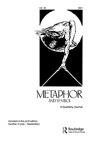Exploring Perceptions of Novelty and Mirth in Elicited Figurative Language Production
IF 3.3
3区 文学
0 LANGUAGE & LINGUISTICS
引用次数: 4
Abstract
ABSTRACT Most research of figurative language production examines naturalistic discourse. However, laboratory studies of elicited figurative language production are useful because they provide insight into whether specific individual differences are associated with differences in figurative language production ability. In this sense, elicited figurative language production studies mirror the approach many studies of figurative language processing and comprehension take. Accordingly, this study is an investigation into perceptions of novelty and mirth associated with figurative language production. Data in this study come from elicited figurative language production tasks for metaphorical comparisons and sarcastic replies, which were rated based on perceptions of novelty and mirth as well as conceptual distance (metaphors) and incongruity (sarcastic replies). Two individual differences, Need for Cognition and Abstract Thinking, along with other differences such as prompt type and production time were used to predict the novelty and mirth ratings. The results demonstrate a significant effect of Need for Cognition on metaphors but not for sarcastic replies, whereas no significant effects were observed for Abstract Thinking. Moreover, longer production times were associated with higher ratings for both metaphors and sarcastic replies. Finally, the results highlighted the manner in which prompt characteristics influenced participants’ responses, especially so for sarcastic replies.在引申的比喻语言生产中探索新奇和欢乐的感知
大多数对具象语言产生的研究都考察自然主义话语。然而,对引发的比喻语言产生的实验室研究是有用的,因为它们可以深入了解特定的个体差异是否与比喻语言产生能力的差异有关。从这个意义上说,引出的比喻语言产生研究反映了许多比喻语言加工和理解研究所采取的方法。因此,本研究是对与具象语言产生相关的新奇感和愉悦感的调查。这项研究中的数据来自于引发的隐喻比较和讽刺回答的比喻语言生产任务,这些任务是根据对新奇和快乐的感知以及概念距离(隐喻)和不协调(讽刺回答)进行评分的。两种个体差异,认知需要和抽象思维,以及其他差异,如提示类型和制作时间,被用来预测新颖性和愉快性评级。研究结果表明,认知需要对隐喻有显著影响,但对讽刺性回答没有显著影响,而对抽象思维没有显著影响。此外,制作时间越长,隐喻和讽刺回复的评分就越高。最后,研究结果强调了提示特征影响参与者反应的方式,尤其是讽刺性回答。
本文章由计算机程序翻译,如有差异,请以英文原文为准。
求助全文
约1分钟内获得全文
求助全文
来源期刊

Metaphor and Symbol
Multiple-
CiteScore
2.90
自引率
0.00%
发文量
23
期刊介绍:
Metaphor and Symbol: A Quarterly Journal is an innovative, multidisciplinary journal dedicated to the study of metaphor and other figurative devices in language (e.g., metonymy, irony) and other expressive forms (e.g., gesture and bodily actions, artworks, music, multimodal media). The journal is interested in original, empirical, and theoretical research that incorporates psychological experimental studies, linguistic and corpus linguistic studies, cross-cultural/linguistic comparisons, computational modeling, philosophical analyzes, and literary/artistic interpretations. A common theme connecting published work in the journal is the examination of the interface of figurative language and expression with cognitive, bodily, and cultural experience; hence, the journal''s international editorial board is composed of scholars and experts in the fields of psychology, linguistics, philosophy, computer science, literature, and media studies.
 求助内容:
求助内容: 应助结果提醒方式:
应助结果提醒方式:


